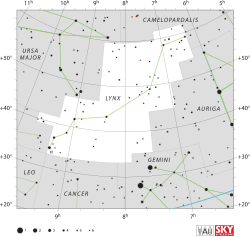36 Lyncis
| 36 Lyncis EI Lyncis | |
 | |
| Observationsdata Epok: J2000.0 | |
|---|---|
| Stjärnbild | Lodjuret |
| Rektascension | 09t 13m 48,21345s[1] |
| Deklination | +43° 13′ 04,1807″[2] |
| Skenbar magnitud () | 5,30[3], +5,32 (0,03)[4] |
| Stjärntyp | |
| Spektraltyp | B8 IIImnp[5] |
| B–V | -0,130 ± 0,003[6] |
| Variabeltyp | Variabel av SX Arietis-typ (SXARI)[4][7] |
| Astrometri | |
| Radialhastighet () | +21,30 ± 1,7[3] km/s |
| Egenrörelse (µ) | RA: -30,392 ± 0,261[1] mas/år Dek.: -31,241 ± 0,293[1] mas/år |
| Parallax () | 5,7249 ± 0,1795[1] |
| Avstånd | 570 ± 20 lå (175 ± 5 pc) |
| Absolut magnitud () | -0,95[3] |
| Detaljer | |
| Radie | 4,21[8] R☉ |
| Luminositet | 443,10[3] L☉ |
| Temperatur | 13 700[9] K |
| Vinkelhastighet | 49 ± 1[5] km/s |
| Andra beteckningar | |
| EI Lyncis, GEN# +1.00079158, NSV 18152, TYC 2990-1662-1, GSC 02990-01662, PMC 90-93 249, UBV 8817, AG+43 883, HD 79158, PPM 51107, UBV M 15170, ALS 16574, HIC 45290, Renson 22480, uvby98 100079158, BD+43 1893, HIP 45290, ROT 1446, WEB 8627, FK5 346, HR 3652, SAO 42759, Gaia DR2 817013387993056640, GC 12716, 2MASS J09134822+4313042, SKY# 17804, GCRV 6025, N30 2185, TD1 13658[10] | |
36 Lyncis, som är stjärnans Flamsteed-beteckning är en ensam stjärna[11] i den norra delen av stjärnbilden Lodjuret, som också har variabelbeteckningen EI Lyncis. Den har en genomsnittlig skenbar magnitud på ca 5,30[3] och är svagt synlig för blotta ögat där ljusföroreningar ej förekommer. Baserat på parallax enligt Gaia Data Release 2 på ca 5,7[1] mas, beräknas den befinna sig på ett avstånd på ca 570 ljusår (ca 175 parsek) från solen. Den rör sig bort från solen med en heliocentrisk radialhastighet av ca 21 km/s.[3]
Egenskaper
[redigera | redigera wikitext]36 Lyncis är en blå till vit jättestjärna av spektralklass B8 IIImnp[5] och är en magnetisk, heliumsvag Bp-stjärna.[12][13] Den klassificeras ibland som en kvicksilver-manganstjärna[14] och är också en "sn"-stjärna som visar ett spektrum med generellt skarpa linjer för de flesta element i kombination med breda, diffusa heliumlinjer.[15] Den har en massa som är ca 2[9] solmassor, en radie som är ca 4,2[8] solradier och utsänder ca 443[3] gånger mera energi än solen från dess fotosfär vid en effektiv temperatur på ca 13 700 K.[9]
36 Lyncis, eller EI Lyncis, är en variabel stjärna av SX Arietis-typ (SXARI),[4] som har visuell magnitud +5,32 och varierar i amplitud med 0,03 magnituder och en period av 3,834 dygn.[4]
Se även
[redigera | redigera wikitext]Referenser
[redigera | redigera wikitext]- Den här artikeln är helt eller delvis baserad på material från engelskspråkiga Wikipedia, 36 Lyncis, 30 mars 2020.
Noter
[redigera | redigera wikitext]- ^ [a b c d e] Brown, A. G. A.; et al. (Gaia collaboration) (August 2018). "Gaia Data Release 2: Summary of the contents and survey properties". Astronomy & Astrophysics. 616. A1. arXiv:1804.09365. Bibcode:2018A&A...616A...1G. doi:10.1051/0004-6361/201833051. Gaia DR2 record for this source at VizieR.
- ^ ”Basic data: V* 36 Lyn – Rotationally variable Star” (på engelska). Centre de Données astronomiques de Strasbourg. http://simbad.u-strasbg.fr/simbad/sim-basic?Ident=36+Lyn&submit=SIMBAD+search. Läst 30 december 2018.
- ^ [a b c d e f g] Anderson, E.; Francis, Ch. (2012). "XHIP: An extended hipparcos compilation". Astronomy Letters. 38 (5): 331. arXiv:1108.4971. Bibcode:2012AstL...38..331A. doi:10.1134/S1063773712050015.
- ^ [a b c d] ”EI Lyn” (på engelska). The International Variable Star Index. AAVSO – American Association of Variable Star Observers. https://www.aavso.org/vsx/index.php?view=detail.top&oid=136468. Läst 30 december 2018.
- ^ [a b c] Cowley, A. (November 1972). "Spectral classification of the bright B8 stars". Astronomical Journal. 77: 750–755. Bibcode:1972AJ.....77..750C. doi:10.1086/111348.
- ^ van Leeuwen (2007). ”Hipparcos, the New Reduction” (på engelska). http://vizier.u-strasbg.fr/viz-bin/VizieR-5?-out.add=.&-source=I/311/hip2&HIP=45290. Läst 30 december 2018.
- ^ Samus, N. N.; et al. (2017). "General Catalogue of Variable Stars". Astronomy Reports. 5.1. 61 (1): 80–88. Bibcode:2017ARep...61...80S. doi:10.1134/S1063772917010085.
- ^ [a b] Shulyak, D.; et al. (2014). "Interferometry of chemically peculiar stars: Theoretical predictions versus modern observing facilities". Monthly Notices of the Royal Astronomical Society. 443 (2): 1629. arXiv:1406.6093. Bibcode:2014MNRAS.443.1629S. doi:10.1093/mnras/stu1259.
- ^ [a b c] Ghazaryan, S.; et al. (November 2018). "New catalogue of chemically peculiar stars, and statistical analysis". Monthly Notices of the Royal Astronomical Society. 480 (3): 2953–2962. arXiv:1807.06902. Bibcode:2018MNRAS.480.2953G. doi:10.1093/mnras/sty1912.
- ^ "36 Lyncis". SIMBAD. Centre de données astronomiques de Strasbourg. Hämtad 2018-12-30.
- ^ Eggleton, P. P.; Tokovinin, A. A. (September 2008). "A catalogue of multiplicity among bright stellar systems". Monthly Notices of the Royal Astronomical Society. 389 (2): 869–879. arXiv:0806.2878. Bibcode:2008MNRAS.389..869E. doi:10.1111/j.1365-2966.2008.13596.x.
- ^ Oksala, M. E.; Silvester, J.; Kochukhov, O.; Neiner, C.; Wade, G. A.; MiMeS Collaboration (January 2018). "Mixed poloidal-toroidal magnetic configuration and surface abundance distributions of the Bp star 36 Lyn". Monthly Notices of the Royal Astronomical Society. 473 (3): 3367–3376. arXiv:1709.08361. Bibcode:2018MNRAS.473.3367O. doi:10.1093/mnras/stx2487.
- ^ Adelman, Saul J. (May 2000). "UVBY photometry of the magnetic CP stars HD 36668, 36 Lyncis, HD 86592, and HR 8861". Astronomy and Astrophysics. 357: 548–552. Bibcode:2000A&A...357..548A.
- ^ Ghazaryan, S.; Alecian, G.; Hakobyan, A. A. (2018). "New catalogue of chemically peculiar stars, and statistical analysis". Monthly Notices of the Royal Astronomical Society. 480 (3): 2953–2962. arXiv:1807.06902. Bibcode:2018MNRAS.480.2953G. doi:10.1093/mnras/sty1912.
- ^ Shore, Steven N.; et al. (September 1987). "The SN Stars: Magnetically Controlled Stellar Winds Among the Helium-Weak Stars". Astronomical Journal. 94: 737. Bibcode:1987AJ.....94..737S. doi:10.1086/114512.
Externa länkar
[redigera | redigera wikitext]
| |||||||||||||||||||
